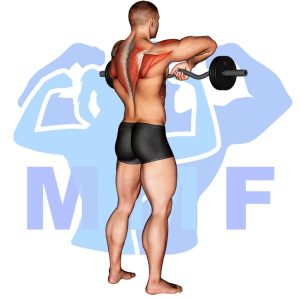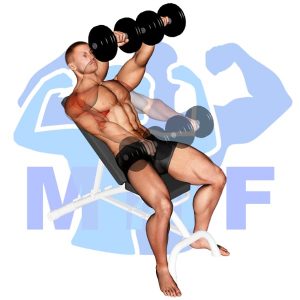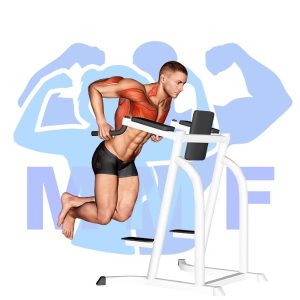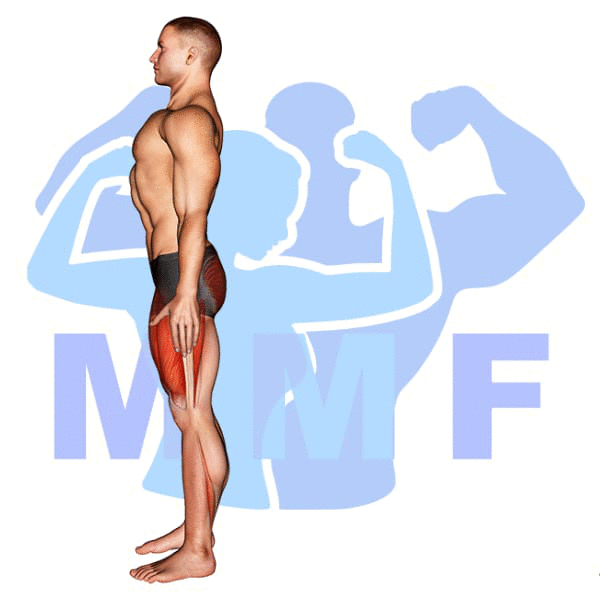Do you struggle with shoulder pain during dumbbell front raises? You’re not alone. It’s a common issue amongst weightlifters and fitness enthusiasts. The reason behind it? Poor form and a lack of knowledge on proper shoulder engagement during the exercise. But don’t worry, this post will provide guidance and tips on how to perform the dumbbell front raise correctly, avoiding shoulder pain and promoting healthy muscle growth.
Dumbbell Front Raise Summary
- Primary Muscles: Deltoid – Lateral
- Secondary Muscles: Deltoid – Anterior, Serratus Anterior, Supraspinatus, Trapezius – Lower, and Trapezius – Middle
- Equipment: Dumbbells
- Mechanics Type: Isolation
- Force: Push
- Utility: Auxiliary

Dumbbell Front Raise Instructions
- Start off by selecting the dumbbells.
- Now, while standing up straight, arms straight in front of you with the dumbbells forward of your hips.
- Next, lift the dumbbells up with your arm straight until they are parallel with the floor.
- Hold the dumbbells in the up position for a short pause, then lower them back to the starting position.
- Continue until you have concluded a full set.
Video Tutorial
Dumbbell Front Raise Muscles
Target (Agonist)
Synergists
Dynamic Stabilizers
- None
Stabilizers
- Levator Scapulae
- Trapezius – Upper
- Wrist Extensors
Antagonist Stabilizers
- None

Benefits of Dumbbell Front Raise
The Dumbbell Front Raise exercise is a great way to strengthen and develop the lateral deltoid muscle. This exercise works to target the lateral deltoid and is great for building shoulder strength, improving posture, and increasing overall shoulder mobility. When performing this exercise, the lateral deltoid is isolated and activated more than any other shoulder muscle, making it an effective way to target the shoulder area specifically. Additionally, the dumbbell front raise helps improve shoulder stability and balance as it works to strengthen the smaller stabilizing muscles in the shoulder joint. This exercise is an important part of any strength training or fitness routine and can help improve overall shoulder health.
Tips for Performing Dumbbell Front Raise
When you wish to achieve the optimal strength gains, you must focus on these basic tips. Most Importantly, whenever you desire to avoid getting injuries, you ought adopt these tips.
- execute your primary compound movements near the beginning of your routine, after that conduct isolation exercises to focus on distinct muscle groups afterwards. You really want the top functionality of your individual muscle groups whenever you do coumpound exercises like, squats, bench, and deadlifts. Next you need to focus on the muscle zones that you determined were weak for those lifts, or zones that couldn’t get fatigued as a result of the type of compound movement you did.
- To Focus On Power And Speed, Bring Up The Acceleration Of Your Movements. Continue to keep excellent technique or you will be more suboptimal to injuries. You should lower the weight to 50-60% of your single rep max weight when training for power. Additionally, you ought to now pause in between every repetition.
- Complete the Proper Number Of Sets Along With Rest. Your target to begin with should be to do 3 sets to near fatigue. In reality, you can build up to 5 sets. If your muscle tissue aren’t tired at the ending of 3 – 5 some thing needs to change. Primarily you can increase the resistance to make each rep harder. Second, you can cut down on the rest time between each set.
- Inhale When You Stretch Your Muscular Tissues And Breathe Out When You Contract Your Muscular Tissues.
Benefits and Tips Video
Frequent Mistakes To Avoid
You must not make these typical issues to have good technique and strength gains. Additionally, when you steer clear of these errors you will prevent the odds of experiencing injuries.
- Don’t Relax Your Stomach. Maintaining your abs tight to protect your spine by maintaining your internal pressure.
- You’ll Do Better To Not By Pass A Warm-Up. getting the blood flowing to your Muscle tissue is the Fastest way to prevent injuries.
- Don’t Forget About Recovery Times. Over-training can actually make you less strong instead of bigger.
Find More Dumbbell Exercises Here
Variations and Complementary Exercises
There are a few different ways to supplement the Dumbbell Front Raise to keep your workout routine varied and interesting. The following list outlines a few variations, complementary, and alternative exercises that target the same muscles as the Dumbbell Front Raise.
Dumbbell Full Can Lateral Raise

The Dumbbell Full Can Lateral Raise is a great complementary or alternative exercise to the Dumbbell Front Raise. This exercise works the same muscles as the Dumbbell Front Raise, but in a different way. The Dumbbell Full Can Lateral Raise involves starting with your arms at your sides, palms facing inwards and keeping your elbows slightly bent. From here, you raise your arms out to the sides until they are parallel to the ground and then return them to the starting position. This exercise helps to strengthen the shoulder muscles and improve overall shoulder stability.
Dumbbell Iron Cross

The Dumbbell Iron Cross is a great alternative or complementary exercise to the Dumbbell Front Raise. This exercise works the deltoids, triceps, and trapezius muscles and is an excellent way to build strength and muscle mass. It involves holding two dumbbells in front of your body at shoulder width while keeping your arms straight and then lifting the dumbbells up and out to each side. This exercise is great for building shoulder stability, as well as targeting the back and chest. The combination of both exercises will help to maximize overall shoulder development.
Dumbbell Lateral Raise

The Dumbbell Lateral Raise is a great complementary or alternative exercise to the Dumbbell Front Raise. This exercise strengthens and tones the shoulder muscles, improving shoulder mobility and stability. It also works the deltoids and trapezius muscles, as well as the rotator cuff. To perform the Dumbbell Lateral Raise, stand with feet shoulder width apart, hold a dumbbell in each hand with palms facing your body, and raise the dumbbells up to shoulder level with arms extended out to the sides. Keep your elbows slightly bent and focus on squeezing your shoulder blades together. Lower the dumbbells back down to the starting position and repeat.
Check Out These Top Dumbbell Exercises
Dumbbell Upright Row

The Dumbbell Upright Row is a great complementary exercise to the Dumbbell Front Raise. It targets the same muscles in the shoulders, such as the front and side deltoids, as well as the trapezius, rhomboids, and biceps. This exercise can be done with either one or two dumbbells and involves lifting the dumbbells up to the chest level while keeping your elbows close to your body. This exercise is ideal for developing muscular strength, size, and definition in the shoulders. It is also a great alternative exercise for those who cannot perform Dumbbell Front Raises due to injury or other limitations.
EZ Bar Upright Row

The EZ Bar Upright Row is a great alternative or complementary exercise for the Dumbbell Front Raise. This exercise helps to strengthen the shoulders, upper back, and arms by targeting the same muscles as the Dumbbell Front Raise. The EZ Bar Upright Row requires the lifter to hold an EZ Bar with an overhand grip and pull it up to the chest while keeping the elbows higher than the hands. This exercise is great for developing strength in the shoulders and upper back while also activating the biceps.
Incline Dumbbell Front Raise

The incline dumbbell front raise is an excellent alternative or complementary exercise to the regular dumbbell front raise. This exercise is performed by standing on an inclined bench and holding a dumbbell in each hand, palms facing down. The arms are raised out in front of the body until they reach shoulder level. The incline position helps to isolate the front deltoids and allows for a greater range of motion compared to the traditional dumbbell front raise. Additionally, it helps to target the upper chest muscles, which can help build overall strength and size.
Find More Shoulders Exercises Here
Opposing Complementary Exercises
To maximize the muscle building benefits of the Dumbbell Front Raise, it is important to include exercises that target opposing muscle groups. This will help to balance your workout, as well as maximize the benefit of the exercises you are doing. Below is a list of exercises that work opposing muscles to the Dumbbell Front Raise.
Chest Dip

The chest dip is a great exercise to complement the dumbbell front raise, as it works the opposing muscle group. It targets the chest, triceps and anterior deltoids, engaging all three of these muscles in a single movement. Chest dips are performed by gripping the dip bars and lowering the body until the chest is parallel with the floor. The slow and controlled motion helps to strengthen and tone the chest, triceps and anterior deltoids while also helping to develop core stability. By performing chest dips in conjunction with dumbbell front raises, you can ensure that all of your upper body muscles are receiving an adequate workout.
Assisted Wide Grip Chest Dip

The Assisted Wide Grip Chest Dip is a great exercise to complement the Dumbbell Front Raise. This exercise works the opposite muscle group, the chest muscles, and helps to increase shoulder stability and strength. The assisted dip allows you to focus on the chest muscles while still providing support to the shoulder muscles. The wide grip position allows for a greater range of motion and helps to target the lower and inner chest muscles, which are often difficult to target with other exercises. The Dumbbell Front Raise focuses on the front deltoids while the Assisted Wide Grip Chest Dip targets the chest, providing balance and symmetry to your upper body workout.
Weighted Tricep Dips

Weighted Tricep Dips are a great exercise to complement Dumbbell Front Raise as they work the opposing muscle group. This exercise involves sitting on a bench and placing your hands on the edge of the bench. Your feet should be placed flat on the floor in front of you, with your legs bent at the knee. You should then lower your body until your elbows are bent at a 90 degree angle, and then press back up to the starting position. This exercise works the triceps, which is an opposing muscle group to the anterior deltoids that are targeted with Dumbbell Front Raise. Therefore, these two exercises together make for a great upper body workout.
Lift Your Way to Stronger Shoulders
Strong shoulders are essential for not only looking great but also for overall upper body strength. One exercise that can help you achieve your shoulder goals is the dumbbell front raise. This exercise targets the front of the shoulder muscles and can be done with a variety of weights. By incorporating the dumbbell front raise into your regular workout routine, you can see improvements in your strength and overall shoulder development. However, as with any exercise, it’s important to start with a weight that is comfortable for you and gradually increase as you get stronger.
References: Wikipedia | ExRx.net | PubMed.gov | Comprehensive List of Shoulders Dumbbell Exercises




